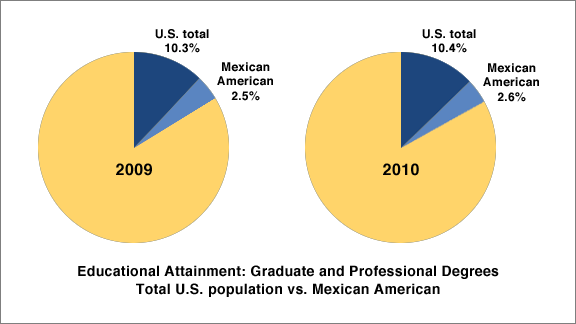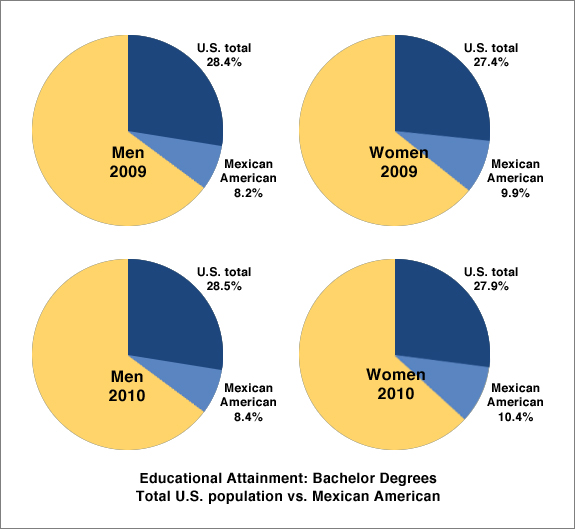

Mother-Daughter Participation in a Community of Practice: Understanding the Sociocultural Mediation of the Identity/ies of Marginalized, 6th Grade Mexican-American Girls
R Reyes III
… introduce participants to how universities function; (3) a Career Day introducing participants to
possible fields of study and to professional Hispanic women who serve as role models; (4) a … The
purpose of this study is to understand how Mexican-American girls who have …
Link to article
Pay attention to Latin America
Pittsburgh Post Gazette
Mexico and Latin America then plunged down the list, displaced by the Middle East and South Asia. Those two regions remain on top of the heap today, in no small part because the Obama administration has continued the military-heavy tilt of US foreign
Link to article
Factors that influence mammography use and breast cancer detection among Mexican-American and African-American women
RZ Garcia, SC Carvajal, AV Wilkinson… – Cancer Causes and …, 2011
… promoting culturally appropriate messaging about the benefits and limitations of mammography,
education about breast awareness, and prompt reporting of findings to a health professional.
Keywords Mammography 4 Screening 4 Acculturation 4 Mexican-American 4 African …
Link to article
Hispanic grocers grab market share
SignOnSanDiego.com
“Instead of us being a Hispanic grocery store,” he said, “we’re a Hispanic grocery store that says: ‘Welcome to Mexico.’”
Link to article
RESULTS OF THE AMERICAN COMMUNITY SURVEY FOR 2010: a comparison of the total population of the United States and Mexican professionals
By HUMBERTO (TITO) GUTIERREZ
Edited by Carol Ponzio
Graphs by Mara Ann Fuller
The total population of the United States is 309,349,689.
The Mexican American population is 32,929,683, roughly about 11% of the total population.
The following are the results of a partial comparison of these two groups for professional occupations.
FOR EDUCATIONAL ATTAINMENT:
- The 2010 Graduate or professional degree was 10.4% for the total population.
- The 2009 Graduate or professional degree was 10.3% for the total population, a gain of .1% for the total population.
- The 2010 Graduate or professional degree was 2.6% for Mexican Americans.
- The 2009 Graduate or professional degree was 2.5% for Mexican Americans, also, a gain of .1%, however the gap is still 7.2% between the total population and Mexican American educational achievement in professional degrees.

These numbers have remained steady for the last two years, but when we look at the breakdown for men vs. women, the numbers are very different.
The 2009 number for male bachelor’s degrees or higher for the total population were 28.4% vs. 8.2% for Mexican Americans.
The 2009 number for female bachelor’s degrees or higher for the total population were 27.4% vs. 9.9% for Mexican American women. The difference between male and female for the total population in 2009 was in favor of males 28.4% vs. 27.4% for females. Males have a 1% advantage. In 2009 there was a 1.7% gap in favor of Mexican American females, 9.9% for women vs. 8.2% for men, a 1.7% advantage for women.
The 2010 number for male bachelor’s degree or higher for the total population was 28.5% vs. 8.4% for Mexican Americans.
The 2010 number for female bachelor’s degree or higher for the total population was 27.9% vs. 10.4% for Mexican Americans. The difference between male and female for the total population in 2010 was in favor of males, 28.5% vs. 27.9% for females, but the gap has narrowed to .6% between the genders, down from 1% in 2009. For Mexican American males the gap in 2010 is 8.4% vs. 10.4% for females, a gap of 2% in favor of females, which have gained from 1.7% in 2009 to 2.0% in 2010.

OCCUPATIONS: Male civilian employed 16 years and over:
- In 2009, management professional and related occupations results were: 32.6% for the total population, vs.12.2% for Mexican Americans.
- In 2010, management professional and related occupations results were: 32.8% for the total population, vs. 12.4% for Mexican Americans. The ratios have remained close for these groups. A gain of .2% by both groups, but Mexican American men are underrepresented by 20.4%, as compared with the total population.
OCCUPATIONS: Female civilian employed 16 years and over:
- In 2009, management professional and related occupations: total population, 39.1%, Mexican American, 21.4%.
- In 2010, management professional and related occupations: total population, 39.4%, Mexican American, 21.7%.
As a general statement the gap between the total population and women is narrower than with men. For women it’s only 17.7% instead of 20.4% for men. What is also of interest is the percentage of women vs. men in this group, which is 9.3% if favor of Mexican American women over Mexican American men.

INDUSTRY: Civilian employed population 16 years and older:
- In 2009, the results for professional, scientific, management, administrative and waste management services were 10.6% for the total populations vs. 10.1% for Mexican American.
- In 2010, the results for professional scientific, and management, and administrative waste management services were 10.6% for the total population vs. 10.1% for Mexican American population. The numbers have remained the same and are one area, which shows equality between the total population and Mexican American population.
For public administration:
- In 2009, the total population was 4.8% in public administration and 3.2% for Mexican Americans.
- In 2010, the total population was 5.2% in public administration and, 3.5% for Mexican Americans. This comparison shows that Mexican Americans lost .1% in this category.
SUMMARY
Ratios of professional employment have remained the same for the total population of the United States vs. the Mexican American population. To a large extent, Mexican American professionals remain underrepresented among professionals in general, but Mexican American women have gained ground in some areas.
Reference Documents from the U.S. Census Bureau
- Census Bureau, Selected Population Profile in the United States: 2010 (a PDF file)
- United States S0201. Selected Population Profile in the United States
Population Group: Mexican
Data Set: 2009 American Community Survey 1-Year Estimates
Survey: American Community Survey
Hispanic grocers grab market share
SignOnSanDiego.com
“Instead of us being a Hispanic grocery store,” he said, “we’re a Hispanic grocery store that says: ‘Welcome to Mexico.’”
Link to article
Greenberg Traurig Opens Office in Mexico City; Expands Latin America Practice
PR Newswire
The office, the firm’s 33rd, will focus on providing legal services to international clients seeking to enter the Mexican and Latin American markets, …
Link to article
The Beginning Of A Multicultural Marketing Approach
MediaPost Publications
by Sebastian Aroca, 4 minutes ago No doubt, Latinos in the US are … and social media but also marketing professionals to look more closely into the US …
Link to article
Business leaders seek immigration changes
Houston Chronicle
Donohue told attendees that the current system doesn’t allow top skilled professionals to remain in the US indefinitely, leaving American businesses with …
Link to article
UCLA School of Law Dean Shares Her Personal Educational Experiences and Pressing Issues Affecting Hispanic Americans
Capital Wire PR
Moran was the keynote speaker at the American Association of Hispanics in Higher … AAHHE supports the development of Hispanic college professionals and is …
Link to article
Transformation taking root in Maverick Square
Boston Globe
But young professionals are buying refurbished condos at about $280 per square foot, … neighborhood with Italian-American roots, even more distinct. …
Link to article
The HNBA Board of Governors and The Board of Directors of The HNBA Legal Education Fund Jointly Announce The Honorable Lupe S. Salinas (Ret.) as Co-Editor of The HNBA Journal of Law and Policy
SYS-CON Media
… a staff attorney with the Mexican-American Legal Defense and Education Fund … legal professionals, and law students of Hispanic descent in the United …
Link to article
Chicano Nations: The Hemispheric Origins of Mexican American Literature By Marissa K. López
MK López – 2011
… lilmnr-null? Page 3. Chicano Nations Page 4. This page intentionally left blank Page
5. Chicano Nations The Hemispheric Origins of Mexican American Literature marissa
k. lópez a New York University Press new york and london Page 6. …
Link to book
Tristezas y Esperanza: The Educational Voices of Six Mexican American Students in a California Urban High School
F Jimenez – 2012
Page 1. Tristezas y Esperanza: The Educational Voices of Six Mexican American Students in
a California Urban High School … The comments of Lenny Corzo reflect the enormity of problems
that Mexican American (MA) students often encounter today in public schools. …
Link to Dissertation
The Importance of Understanding the Growing U.S. Latino Market Online
PBS MediaShift
That roughly equates to 1 in 3 Americans. As new media professionals, … may not even identify as US Latino, such as Chicanos (Mexican-Americans). …
Link to article
Celebvocate: Gael García Bernal speaks up for Latin American migrants
Washington Post
(Courtesy of WOLA) An occasional look at the showbiz professionals flacking causes … Tuesday’s trouper: Gael Garcia Bernal Bona Fides: Mexican art-house …
Link to article
Higher Ed Partnerships
USAID
… and more than 1000 SBDC professionals from every Mexican state have graduated from … Several other Latin American countries have expressed interest in …
Acculturation Factors Are Associated with Folate Intakes among Mexican American Women
HC Hamner, ME Cogswell… – The Journal of Nutrition, 2011
Page 1. The Journal of Nutrition Nutritional Epidemiology Acculturation Factors Are
Associated with Folate Intakes among Mexican American Women 1,2,3 Heather
C. Hamner,4* Mary E. Cogswell, 5 and Mary Ann Johnson6 …
Link to abstract
NEGOTIATIONS OF POWER IN MEXICAN AND MEXICAN AMERICAN WOMEN‟S NARRATIVES
CL McNabb – 2011
… This thesis examines casual storytelling among Mexican and Mexican American women in Oaxaca,
Mexico and Eugene, Oregon. … PROFESSIONAL EXPERIENCE: Graduate Teaching Fellow, Folklore
Archivist, University of Oregon Spring 2011, Spring 2010, Winter 2010 …
link to thesis
Debated Whiteness amid World Events: Mexican and Mexican American Subjectivity and the US’Relationship with the Americas, 1924-1936
M Calderón-Zaks – Mexican Studies/Estudios Mexicanos, 2011
Page 1. Debated Whiteness amid World Events: Mexican and Mexican American
Subjectivity and the US’ Relationship with the Americas, 1924–1936 Michael
Calderón-Zaks Independent Scholar By the 1920s, anti-Mexican …


